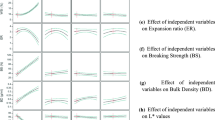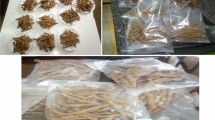Abstract
Extrusion cooking is recognised as a smart technology for food processors. It requires low cost, high temperature, short-time process and few ingredients to create a puffed snack. The only drawback is that it contains multiple parameters that need to be rigorously trialled to develop an optimal process. This study investigated the effects of two extruding parameters (die head temperature and screw speed) and examined the addition of apple pomace into a corn flour-based extruded snack formulation. A response surface design was utilised. A D-optimal design was chosen, which generated 21 combinations; within these combinations, the control formulation existed. Extrudate characteristics, i.e. bulk density and porosity, textural properties, cooked starch properties and moisture, were analysed. Screw speed was found to have the greatest effect on extrudate quality, e.g. bulk density increased as the screw speed increased (p < 0.001). Both apple pomace addition and screw speed impacted expansion ratio; as they increased, expansion decreased (p < 0.0001). The optimised and validated formulation contained the following parameter levels: 7.7 % apple pomace, 150 °C die head temperature and a screw speed of 69 rpm. As apple pomace and corn flour are naturally gluten free, the extruded product would appeal to people who suffer from intolerances, allergies and coeliac disease.





Similar content being viewed by others
References
AACC Method 44-15A (1991) Moisture: Air oven methods. Washington: AACC
AACC Method 62–05 (1991) Preparation of sample: bread Brabender moisture oven, manufacturer’s handbook. Washington: AACC
Altan, A., McCarthy, K. L., & Maskan, M. (2008a). Evaluation of snack foods from barley–tomato pomace blends by extrusion processing. Journal of Food Engineering, 84(2), 231–242.
Altan, A., McCarthy, K. L., & Maskan, M. (2008b). Twin-screw extrusion of barley–grape pomace blends: Extrudate characteristics and determination of optimum processing conditions. Journal of Food Engineering, 89(1), 24–32.
Altan, A., McCarthy, K. L., & Maskan, M. (2009). Effect of extrusion cooking on functional properties and in vitro starch digestibility of barley-based extrudates from fruit and vegetable by-products. Journal of Food Science, 74(2), E77–E86.
Asare, E. K., Sefa-Dedeh, S., Sakyi-Dawson, E., & Afoakwa, E. O. (2004). Application of response surface methodology for studying the product characteristics of extruded rice–cowpea–groundnut blends. International Journal of Food Sciences and Nutrition, 55(5), 431–439.
Brennan, M. A., Derbyshire, E., Tiwari, B. K., & Brennan, C. S. (2013). Ready-to-eat snack products: The role of extrusion technology in developing consumer acceptable and nutritious snacks. International Journal of Food Science & Technology, 48(5), 893–902.
Carvalho, C. W. P., Takeiti, C. Y., Onwulata, C. I., & Pordesimo, L. O. (2010). Relative effect of particle size on the physical properties of corn meal extrudates: Effect of particle size on the extrusion of corn meal. Journal of Food Engineering, 98(1), 103–109.
Chang, Y. H., & Ng, P. K. W. (2011). Effects of extrusion process variables on quality properties of wheat–ginseng extrudates. International Journal of Food Properties, 14(4), 914–925.
Chang, Y. K., Silva, M. R., Gutkoski, L. C., Sebio, L., & Da Silva, M. A. A. P. (1998). Development of extruded snacks using jatobá (Hymenaea stigonocarpa Mart) flour and cassava starch blends. Journal of the Science of Food and Agriculture, 78(1), 59–66.
Chessari, C.J. & Sellahewa, J.N. (2000). Effective process control. In: R. Guy (ed.) Extrusion cooking technologies and applications (pp. 83–107). Cambridge: Woodhead
de Mesa, N. J. E., Alavi, S., Singh, N., Shi, Y.-C., Dogan, H., & Sang, Y. (2009). Soy protein-fortified expanded extrudates: Baseline study using normal corn starch. Journal of Food Engineering, 90(2), 262–270.
Dehghan-Shoar, Z., Hardacre, A. K., & Brennan, C. S. (2010). The physico-chemical characteristics of extruded snacks enriched with tomato lycopene. Food Chemistry, 123(4), 1117–1122.
Frame, N.D. (1994). Operational characteristics of the co-rotating twin-screw extruder. In: N. D. Frame (ed). The technology of extrusion cooking (pp. 1–51). Glasglow: Blackie Academic & Professional.
Gorinstein, S., Zachwieja, Z., Folta, M., Barton, H., Piotrowicz, J., Zemser, M., & Martin-Belloso, O. (2001). Comparative contents of dietary fiber, total phenolics, and minerals in persimmons and apples. Journal of Agricultural and Food Chemistry, 49(2), 952–957.
Hossain, M. B., Brunton, N. P., Martin-Diana, A. B., & Barry-Ryan, C. (2010). Application of response surface methodology to optimize pressurized liquid extraction of antioxidant compounds from sage (Salvia officinalis L.), basil (Ocimum basilicum L.) and thyme (Thymus vulgaris L.). Food & Function, 1(3), 269–277.
Hossain, M. B., Brunton, N. P., Patras, A., Tiwari, B., O’Donnell, C. P., Martin-Diana, A. B., & Barry-Ryan, C. (2012). Optimization of ultrasound assisted extraction of antioxidant compounds from marjoram (Origanum majorana L.) using response surface methodology. Ultrasonics Sonochemistry, 19(3), 582–590.
Karkle, E. L., Alavi, S., & Dogan, H. (2012). Cellular architecture and its relationship with mechanical properties in expanded extrudates containing apple pomace. Food Research International, 46(1), 10–21.
Ktenioudaki, A., O’Shea, N., & Gallagher, E. (2012). Rheological properties of wheat dough supplemented with functional by-products of foodprocessing: Brewer’s spent grain and apple pomace. Journal of Food Engineering, 116, 362–368.
McCarthy, D. F., Gallagher, E., Gormley, T. R., Schober, T. J., & Arendt, E. K. (2005). Application of response surface methodology in the development of gluten-free bread. Cereal Chemistry, 82(5), 609–615.
Meng, X., Threinen, D., Hansen, M., & Driedger, D. (2010). Effects of extrusion conditions on system parameters and physical properties of a chickpea flour-based snack. Food Research International, 43(2), 650–658.
Moraru, C. I., & Kokini, J. L. (2003). Nucleation and expansion during extrusion and microwave heating of cereal foods. Comprehensive Reviews in Food Science and Food Safety, 2(4), 147–165.
Nascimento, E. M. d. G. C. d., Carvalho, C. W. P., Takeiti, C. Y., Freitas, D. D. G. C., & Ascheri, J. L. R. (2012). Use of sesame oil cake (Sesamum indicum L.) on corn expanded extrudates. Food Research International, 45, (1), 434–443.
O’Shea, N., Arendt, E. K., & Gallagher, E. (2012). Dietary fibre and phytochemical characteristics of fruit and vegetable by-products and their recent applications as novel ingredients in food products. Innovative Food Science & Emerging Technologies, 16, 1–10.
Ozcan, S., & Jackson, D. S. (2005). Functionality behavior of raw and extruded corn starch mixtures. Cereal Chemistry Journal, 82(2), 223–227.
Pastor-Cavada, E., Drago, S. R., González, R. J., Juan, R., Pastor, J. E., Alaiz, M., & Vioque, J. (2011). Effects of the addition of wild legumes (Lathyrus annuus and Lathyrus clymenum) on the physical and nutritional properties of extruded products based on whole corn and brown rice. Food Chemistry, 128(4), 961–967.
Pérez, A. A., Drago, S. R., Carrara, C. R., De Greef, D. M., Torres, R. L., & González, R. J. (2008). Extrusion cooking of a maize/soybean mixture: Factors affecting expanded product characteristics and flour dispersion viscosity. Journal of Food Engineering, 87(3), 333–340.
Rosell, C. M., Santos, E., & Collar, C. (2009). Physico-chemical properties of commercial fibres from different sources: A comparative approach. Food Research International, 42(1), 176–184.
Rossle, C., Ktenioudaki, A., & Gallagher, E. (2011). Inulin and oligofructose as fat and sugar substitutes in quick breads (scones): A mixture design approach. European Food Research and Technology, 233(1), 167–181.
Saeleaw, M., Dürrschmid, K., & Schleining, G. (2012). The effect of extrusion conditions on mechanical-sound and sensory evaluation of rye expanded snack. Journal of Food Engineering, 110(4), 532–540.
Singh, B., Sekhon, K. S., & Singh, N. (2007). Effects of moisture, temperature and level of pea grits on extrusion behaviour and product characteristics of rice. Food Chemistry, 100(1), 198–202.
Stojceska, V., Ainsworth, P., Plunkett, A., & İbanoğlu, Ş. (2009). The effect of extrusion cooking using different water feed rates on the quality of ready-to-eat snacks made from food by-products. Food Chemistry, 114(1), 226–232.
Stojceska, V., Ainsworth, P., Plunkett, A., & İbanoğlu, Ş. (2010). The advantage of using extrusion processing for increasing dietary fibre level in gluten-free products. Food Chemistry, 121(1), 156–164.
Taniwaki, M., & Kohyama, K. (2012). Mechanical and acoustic evaluation of potato chip crispness using a versatile texture analyzer. Journal of Food Engineering, 112(4), 268–273.
van der Sman, R. G. M., & Broeze, J. (2013). Structuring of indirectly expanded snacks based on potato ingredients: A review. Journal of Food Engineering, 114(4), 413–425.
Wijngaard, H. H., Rößle, C., & Brunton, N. (2009). A survey of Irish fruit and vegetable waste and by-products as a source of polyphenolic antioxidants. Food Chemistry, 116(1), 202–207.
Yagci, S., & Gogus, F. (2008). Response surface methodology for evaluation of physical and functional properties of extruded snack foods developed from food-by-products. Journal of Food Engineering, 86(1), 122–132.
Yagci, S., & Gogus, F. (2009). Development of extruded snack from food by-products: A response surface analysis. Journal of Food Process Engineering, 32(4), 565–586.
Yang, S.-h., Peng, J., Lui, W.-B., & Lin, J. (2008). Effects of adlay species and rice flour ratio on the physicochemical properties and texture characteristic ofadlay-based extrudates. Journal of Food Engineering, 84(3), 489–494.
Acknowledgements
The research was funded by the Department of Agriculture, Food and the Marine under the Food Institutional Research Measure (FIRM) and the Walsh Fellowship program. The authors would like to acknowledge Ms Paula Reid for all her help and advice on the statistics.
Author information
Authors and Affiliations
Corresponding author
Rights and permissions
About this article
Cite this article
O’Shea, N., Arendt, E. & Gallagher, E. Enhancing an Extruded Puffed Snack by Optimising Die Head Temperature, Screw Speed and Apple Pomace Inclusion. Food Bioprocess Technol 7, 1767–1782 (2014). https://doi.org/10.1007/s11947-013-1181-x
Received:
Accepted:
Published:
Issue Date:
DOI: https://doi.org/10.1007/s11947-013-1181-x




